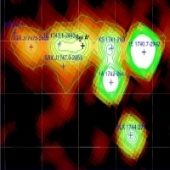ESA Science & Technology - Science Results
Science Results
Science Results
Published 8 November 2005 in Annales Geophysicae, an article by Zhang et al. presents the first ever simultaneous observation of neutral sheet oscillations over a distance of 5 Earth radii.
Published: 30 March 2006
INTEGRAL has detected surprisingly powerful X-ray and gamma ray emission from a special class of neutron star, known as Anomulous X-ray Pulsars (AXP), which proves them to be among the most magnetically active bodies known.
Published: 17 March 2006
On the night of 13 March 1986 the Giotto spacecraft passed within 600 km of the core of comet 1P/Halley. Launched eight months earlier on 2 July 1985, Giotto was the first spacecraft to visit a comet's nucleus and represented ESA's first deep space mission.
Published: 13 March 2006
In an article recently published in the Physical Review Letters, a team of scientists led by Dr Fouad Sahraoui reveal their unique new findings on the turbulent processes in the Earth's magnetosheath region.
Published: 24 February 2006
In a dedicated Nature paper, T. Phan et al. shed light on the nature and scale of the magnetic reconnection process, based on Cluster, ACE and WIND observations.
Published: 11 January 2006
Published: 22 December 2005
This dramatic view of the star forming region around the star cluster NGC 346 was created from visible and infrared images with Hubble's Advanced Camera for Surveys.
Published: 10 November 2005
In two dedicated papers, INTEGRAL Project Scientist Christoph Winkler presents a selection of scientific highlights achieved during the first two and a half years of Integral science operations.
Published: 7 October 2005
Published: 21 September 2005
The Double Star TC-2 and Cluster satellites have gathered unique data from the biggest starquake on a neutron star ever recorded, enabling the discrimination between current theories on the origin of these type of events.
Published: 21 September 2005
Observations with the Hubble Space Telescope have revealed the presence of a compact disk of young stars at the heart of the Andromeda galaxy surrounding the central black hole.
Published: 20 September 2005
In an article to be published in the Astrophysical Journal, Bélanger et al. report on the nature of a hard X-ray source located near and associated with the black hole at the centre of our galaxy.
Published: 14 September 2005
A number of interesting papers have recently been published based on data gathered by INTEGRAL - ESA's gamma-ray observatory. They cover a range of observations covering all the capabilities of the spacecraft.
Published: 16 August 2005
Published: 11 August 2005
A publication in the Annales Geophysicae reports on the first ever measurement of the current density in the ring current region using data from the Cluster spacecraft.
Published: 28 July 2005
The OMC onboard INTEGRAL was triggered via the INTEGRAL Burst Alert System last week in an attempt to view the optical counterpart to a Gamma-ray Burst. Unfortunately the star alpha Crucis got in the way.
Published: 8 July 2005
Five months after its successful descent onto Titan, scientists analyzing data from the various instruments have begun to publish a wide range of results.
Published: 17 June 2005
Bertaux et al. report in the science journal Nature that SPICAM observations of the Martian nightside limb have found the first evidence of auroral activity in the Martian atmosphere
Published: 10 June 2005
Published: 9 June 2005
Already during the Lunar commissioning phase SMART-1's payload is gathering results, among which the first ever remote detection of calcium on the Moon.
Published: 8 June 2005
—
20 Items per Page



















